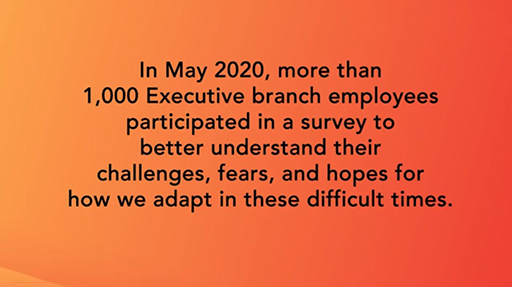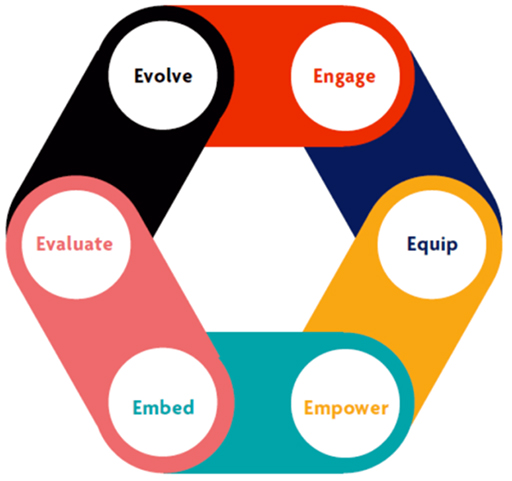4 Maintaining the momentum
An organisational push to introduce new initiatives can create momentum and enthusiasm, but what can you do to maintain that momentum when the initial impetus wears off?
Internal communication
Whether you have a dedicated department or not, internal communication plays a significant role in keeping inclusion in the minds of all your employees and demonstrating your continued commitment as an organisation.
Norton (2020) has created a series of short videos explaining the importance of internal comms (IC) in promoting the diversity agenda. You can find them in Norton’s blog post, listed in the References section, but the one highlighted here includes some really useful tips about planning a calendar of messages throughout the year.

Transcript: Video 7: Planning a calendar
Here is an example of an interesting campaign idea:
Box _unit8.5.1 Johnson & Johnson’s ‘You Belong’ campaign (Lee, 2019)
It became clear that despite offering initiatives celebrating various diverse groups, ‘these principally catered to employees who were already assured with their identities’. Creating the ‘You Belong’ campaign, encouraging staff to bring their ‘whole selves’ to work, allowed the company to empower less confident employees to feel more comfortable being themselves in the workplace.
‘You Belong [Tip: hold Ctrl and click a link to open it in a new tab. (Hide tip)] ’ has a dedicated website which reviews the impact of the campaign annually, sharing data and stories. Lee offers this advice:
‘take a look at your workforce and determine which groups of people could feel underrepresented and undervalued. Be genuine and show them that you cherish them, whether that be through developing policies that support them or launching internal campaigns that celebrate them. Internal communications are hugely valuable here, and we’ve found that our ‘You Belong’ campaign has been immeasurably effective.’
While you might not have the resources to create a dedicated newsletter or website, there’s no reason why you can’t communicate diversity and inclusion topics elsewhere, for example in your regular all staff emails or in a designated section of a more general staff newsletter.
Employee surveys
Regular feedback from employees plays a crucial role in keeping you up-to-date with diversity and inclusion in your organisation.
Often this involves measuring engagement through a staff survey. If you don’t already have inclusion related statements for staff to respond to, adding the following would allow you to explore their feelings (Maltese, 2020):
- My opinions seem to count at work (a positive response tells you ‘I feel heard’)
- The people I work with treat each other with respect (tells you ‘I feel respected’)
- If I contribute to the organisation’s success, I know I will be recognised (tells you ‘I feel valued’).
The data you collect can help you measure the impact of what you are currently doing, but can also help you to plan what to do next.
An important part of the survey process is encouraging as many staff members as possible to complete it. This might involve clarifying the importance of collecting diversity data and how it can impact on your approach to inclusion.
Box _unit8.5.2 Lloyds Banking Group (McGregor-Smith review, no date)
Lloyds Banking Group launched regular communication campaigns, sponsored by senior leadership, to encourage colleagues to complete all personal details (including ethnicity, disability, sexual orientation) on their HR system. They linked the request to complete personal data with their Group purpose of Helping Britain Prosper through better representing the customers and communities they serve. This gave colleagues a positive reason to share their information.
The communication campaign was supported by equipping leadership and line managers with a guidance pack, including FAQs, to help them explain to colleagues the positive benefits of having accurate data around the diversity of the workforce. Since the launch of the communications campaign, they saw a 4% increase in completion of ethnic origin data, equating to over 3,000 colleagues voluntarily updating their details.
Another approach, undertaken more frequently than the larger staff survey, is the ‘pulse survey’ – designed to quickly collect employee opinion about key workplace issues, i.e. to measure the workforce’s pulse.
Stange (2020) explains that a pulse survey should be short, simple, flexible and targeted, and can help you to increase transparency, build trust, improve culture and collect real time feedback to measure impact and inform your decision making – ideal in the diversity and inclusion context.
A crucial part of the feedback loop is providing information on the actions you’ve taken following survey findings.
Box _unit8.5.3 King County employees
King County is a US county in Washington State. Following a pulse survey of employees across the county, with a focus on the pandemic and remote working, it created this short film to highlight its findings and actions:

Standards, frameworks and accreditation
Connecting and collaborating with organisations that are able to provide support and advice on specific areas of diversity can also help to maintain activity levels. As many of these organisations operate as consultancies, in most cases there will be a fee for their feedback and expertise.
One high profile organisation operating across all sectors is Stonewall, which runs two indices to help you assess your progress on LGBT inclusion in the workplace – one UK based, and the other global.
Other organisations are sector specific, recognising and responding to a particular issue. For example, in the HE and research sector, the Athena Swan Charter is a framework that encourages and recognises commitment to advancing gender equality. Organisations can apply for institutional and departmental Athena Swan awards recognising their gender equality efforts.
The Inclusive Employers Standard is an evidence-based workplace accreditation tool for inclusion and diversity. Participants answer 35 questions that cover all the protected characteristics and wider themes, and responses are used to measure inclusion and diversity and to assess where you are on your journey.
The questions are divided across six pillars of inclusion that measure all areas of inclusion and diversity activity.
Box _unit8.5.4 The Calico Group (Inclusive Companies, 2020)
The Calico Group are a group of innovative charities and business working together to make social rather than financial profit. Working towards the Inclusive Employers Standard, they jumped a significant 20 places to rank 5th in the Inclusive Top 50 UK Employers List 2020/21. Some of the actions that supported this improvement include:
- making their diversity and inclusion strategy easily accessible on their intranet
- setting up ‘This is me’ diversity networks across the organisation to celebrate and champion diversity through lived experience
- delivering diversity and inclusion refresher training three times per year
- measuring inclusion across the whole Group through monthly key performance indicators
- identifying that their employees were aging and subsequently introducing an innovative and unconventional recruitment campaign via WhatsApp to attract younger applicants
- tailoring their wellbeing offer to their older workforce, e.g. through retirement planning and menopause workshops.
Another useful organisation to be aware of is Business in the Community, which works with its members ‘to continually improve their responsible business practice, leveraging the collective impact for the benefit of communities.’ The cost of membership depends on the size and turnover of your organisation and the level of service you want access to.
There are some resources you can access without being a member, such as their downloadable toolkit (BITC, 2020), offering guidance on diversity and inclusion strategy and policy. Find the link in References.
Activity _unit8.5.1 Activity 4 Who could your organisation connect with?
Consider a current diversity related weakness within your workplace and, using your preferred search engine – make a list of the external organisations that might provide support and advice on that issue.
Or you might choose to explore the costs and benefits of membership of Inclusive Employers or Business in the Community.
Comment
It can also be useful to talk with contacts/peers within other organisations to explore what steps they have taken.
There are a wide number of consultancies and charitable organisations who can provide support, ranging from delivering training courses to helping you review your policies and procedures.


